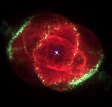
Education and Outreach Page
![]()
Here is a little presentation I put together in an attempt to make the concept of a "billion" people understandable (at some level!). It ends with a twist to put the expected increase in world population into context. Hope you like it! Available in Powerpoint (<1 Mb) or PDF (<18 Mb) formats.
The immensity of the Universe is at best difficult to fathom. Huge distances and sizes, expressed in millions of miles or light years, just become "big" numbers to our ears; they really have no meaning. In giving numerous presentations to various school groups or in making public presentations, I have developed some simple demonstrations that have been effective in communicating a sense of the size and scale of the solar system, the galaxy, and the Universe. If this sounds interesting to you, the following two write-ups may be of some interest:
This is a web-based, self-contained exercise for middle school level that can be printed out and used or just appreciated on-line. Uses real Hubble and ground-based data with simple arithmetic and an eensy-weensy bit of trigonometry to calculate the distance to the Cygnus Loop supernova remnant, just like a real astronomer would do it!.
It is truly amazing that we can learn so much about objects in the distant Universe just by analyzing the light that they send us across the endless void of space. Everyone is familiar with the astonishing and beautiful astronomical images obtained by large ground-based and space-based telescopes such as those at Mount Palomar, Kitt Peak, and of course, the Hubble Space Telescope. But much of our information about the Universe comes out of a technique called astronomical spectroscopy, where the light from an object is dispersed into into a spectrum for analysis. The Hubble, for instance, carries both cameras and spectrographs, and yet what does the public ever hear about the results from the spectrographs, which is where the real quantitative information is obtained? Nothing!
As my own personal attempt to combat this situation, I have developed a Web site that attempts to describe the "Basics of Light" and "Astronomical Spectroscopy" at a level understandable at the junior high to high school level. I have no pretenses that you will ever see an astronomical spectrum in your local newspaper, but hopefully a few interested souls will find their way here and realize that there is more to astronomy than taking pretty pictures! If you are one of the few, CLICK HERE to begin the adventure!
Astro-2: A Mission Made in Heaven
Astro-2 was a space shuttle mission dedicated to astronomy that flew on the shuttle Endeavour in March 1995. Bill was involved with the Hopkins Ultraviolet Telescope, which flew as part of this mission. This description, written like a popular-level magazine article, provides an insider's view into this mission, and contains links to lots of related information as well. Click here to access this article.
Having come down off of my soapbox (see above), this is NOT to say that astronomical images are not fascinating and beautiful! And they do also convey real information about the objects being observed. Here are a couple of results that I have been associated with that have produced interesting visual results. I hope you enjoy them!
(I will add new images here as time permits.)
If you find these materials helpful, or if you have suggestions for improvements, I would enjoy hearing from you! (No promises, however. I have to do this in my spare time, of which there is essentially none!)
![]()
Last updated: March 2011.
Bill Blair ([email protected])